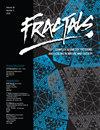分数阶微积分算子- Bloch-Torrey偏微分方程-人工神经网络-脑组织微观宏观结构的计算复杂性建模与扩散MRI信号处理和神经元多组分
IF 2.9
3区 数学
Q1 MATHEMATICS, INTERDISCIPLINARY APPLICATIONS
Fractals-Complex Geometry Patterns and Scaling in Nature and Society
Pub Date : 2023-10-20
DOI:10.1142/s0218348x23402041
引用次数: 0
摘要
分数阶演算和分数阶演算在数学模型上按谱系排列,这些数学模型具有复杂性理论原理,能够通过将幂律卷积核积分到与时间和空间相关的导数中来捕捉微妙的分子动力学,这些导数出现在涉及扩散和松弛分数模型的磁共振成像(MRI)现象的方程中。人脑作为一种异质介质,由分布在细胞外空间的不同大小和形状的细胞组织组成,具有复杂的复杂性和独特的分子和细胞水平的物理和结构支架,其中许多突触形成了复杂的神经网络,需要对单个细胞和神经元的模式和特征进行深入的探测和计算。独特的脑细胞的特征是寻求揭示不同细胞和组织之间的联系,以实现准确,可靠,稳健和最佳的模型和计算。因此,扩散磁共振成像(Diffusion Magnetic Resonance Imaging, DMRI)作为一种具有临床和研究应用的非侵入性、实验性成像技术,提供了一种与水在生物组织,特别是脑组织中的扩散特性相关的测量方法。与这些方面相适应,DMRI技术超越了扩散系数的测量,旨在超越MRI图像的空间分辨率,并从相关介质的微观结构特性中推断。因此,新的工具对于描述生物(细胞器、膜、大分子等)和神经(轴突、树突、神经元等)组织的复杂性至关重要。基于数学模型的计算分析,采用多方面的方法从SpinDoctor的DMRI中提取信息到神经元动力学中,可以提供定量的参数化工具,以反映组织特性,重点关注组织微观结构与先进医学成像技术获取的信号之间的精确联系。结合精确的神经元几何模型和数值DMRI模拟,建立了一种基于SpinDoctor和Bloch-Torrey偏微分方程(BTPDE)和三参数Caputo分数阶导数(FOD)的新型扩展的多面预测数学模型。在我们的研究中,我们提出并发展了Mittag-Leffler函数(MLF),并通过相关的多阶段应用相关步骤扩展了该函数在脑神经元自旋单元数据集上的应用。将具有BFGS准牛顿方程的前馈神经网络(FFNNs)作为人工神经网络(ANN)算法的一种,应用于神经元的Caputo分数阶导数的BTPDE,并通过建立基于不同分数阶Caputo FOD神经元的BTPDE模型来计算其算法复杂度。所提出和开发的模型的分数阶度与它们对应的复杂程度有关。因此,将仿真驱动的FFNN (BFGS拟牛顿方程)学习方案应用于本研究提出的Bloch-Torrey PDE-Caputo基于MLF神经元模型(命名为FFNN - btpde - cfodmlf神经元模型)进行实验和观察。因此,通过研究基于所获得的精确神经元几何模型的数学模型是否可以通过比较误差来优化,以定义顺序参数,并识别误差与预测结果的最佳程度,特别是神经元模型,我们已经能够通过DMRI来估计和预测大脑的微观结构。在利用和证实强大的建模和计算能力的基础上,强调数学和医学贡献。本文章由计算机程序翻译,如有差异,请以英文原文为准。
Fractional Calculus Operators - Bloch-Torrey Partial Differential Equation - Artificial Neural Networks-Computational Complexity Modeling of the Micro-Macrostructural Brain Tissues with Diffusion MRI Signal Processing and Neuronal Multicomponents
Fractional calculus and fractional-order calculus are arranged in lineage as regards the mathematical models with complexity-theoretical tenets capable of capturing the subtle molecular dynamics by the integration of power-law convolution kernels into time- and space-related derivatives emerging in equations concerning the Magnetic Resonance Imaging (MRI) phenomena to which the fractional models of diffusion and relaxation are applied. Endowed with an intricate level of complexity and a unique physical and structural scaffolding at molecular and cellular levels with numerous synapses forming elaborate neural networks which entail in-depth probing and computing of patterns and signatures in individual cells and neurons, human brain as a heterogeneous medium is constituted of tissues with cells of different sizes and shapes, distributed across an extra-cellular space. Characterization of the unique brain cells is sought after to unravel the connections between different cells and tissues for accurate, reliable, robust and optimal models and computing. Accordingly, Diffusion Magnetic Resonance Imaging (DMRI), as a noninvasive and experimental imaging technique with clinical and research applications, provides a measure related to the diffusion characteristics of water in biological tissues, particularly in the brain tissues. Compatible with these aspects and beyond the diffusion coefficients’ measurement, DMRI technique aims to exceed the spatial resolution of the MRI images and draw inferences from the microstructural properties of the related medium. Thus, novel tools become essential for the description of the biological (organelles, membranes, macromolecules and so on) and neurological (axons, dendrites, neurons and so forth) tissues’ complexity. Mathematical model-based computational analyses with multifaceted methods to extract information from the DMRI with SpinDoctor into neuronal dynamics can provide quantitative parametric instruments in order to reflect the tissue properties focusing on the precise link between the tissue microstructure and signals acquired by employing advanced medical imaging technologies. Coalesced with accurate neuron geometry models as well as numerical DMRI simulations, a novel extended and multifaceted predictive mathematical model based on SpinDoctor and Bloch–Torrey partial differential equation (BTPDE) with the Caputo fractional-order derivative (FOD) with three-parameter [Formula: see text] Mittag-Leffler function (MLF) has been proposed and developed in our study by extending for the application on Brain Neuron Spin Unit dataset with the relevant multi-stage application-related steps. The feedforward neural networks (FFNNs) with BFGS Quasi-Newton equation, as one of the artificial neural network (ANN) algorithms, are applied on BTPDE with Caputo fractional-order derivative for the neurons and their algorithmic complexity is computed by building a BTPDE with Caputo FOD Neuron model based on different fractional orders. The fractional-order degree of the proposed and developed model is applied in relation to their corresponding complexity degrees. Consequently, experimentation and observations from the simulation-driven FFNN (with BFGS Quasi-Newton equation) learning scheme applied to the Bloch–Torrey PDE–Caputo FOD with MLF Neuron model (named as FFNN–BTPDE–CFODMLF Neuron model) proposed in this study, are made. Thus, by investigating whether the mathematical models based on the accurate neuron geometry models obtained can be optimized by comparing the errors in order to define the order parameter and identify to what optimal extent the errors are in relation to the prediction results with a particular focus on the neuron model, we have been able to estimate and predict brain microstructure through DMRI, accentuating mathematical and medical contributions based on the exploitation and corroboration of powerful modeling as well as computational capabilities.
求助全文
通过发布文献求助,成功后即可免费获取论文全文。
去求助
来源期刊
CiteScore
7.40
自引率
23.40%
发文量
319
审稿时长
>12 weeks
期刊介绍:
The investigation of phenomena involving complex geometry, patterns and scaling has gone through a spectacular development and applications in the past decades. For this relatively short time, geometrical and/or temporal scaling have been shown to represent the common aspects of many processes occurring in an unusually diverse range of fields including physics, mathematics, biology, chemistry, economics, engineering and technology, and human behavior. As a rule, the complex nature of a phenomenon is manifested in the underlying intricate geometry which in most of the cases can be described in terms of objects with non-integer (fractal) dimension. In other cases, the distribution of events in time or various other quantities show specific scaling behavior, thus providing a better understanding of the relevant factors determining the given processes.
Using fractal geometry and scaling as a language in the related theoretical, numerical and experimental investigations, it has been possible to get a deeper insight into previously intractable problems. Among many others, a better understanding of growth phenomena, turbulence, iterative functions, colloidal aggregation, biological pattern formation, stock markets and inhomogeneous materials has emerged through the application of such concepts as scale invariance, self-affinity and multifractality.
The main challenge of the journal devoted exclusively to the above kinds of phenomena lies in its interdisciplinary nature; it is our commitment to bring together the most recent developments in these fields so that a fruitful interaction of various approaches and scientific views on complex spatial and temporal behaviors in both nature and society could take place.

 求助内容:
求助内容: 应助结果提醒方式:
应助结果提醒方式:


